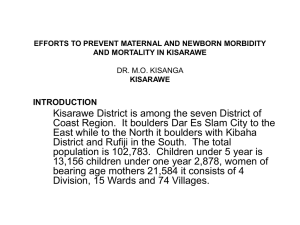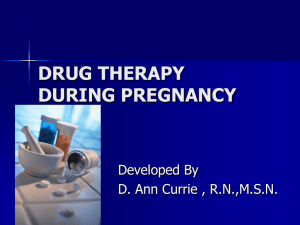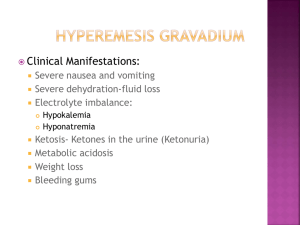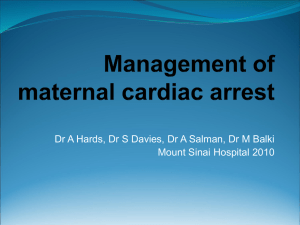G Common Medical Complications of Pregnancy
advertisement
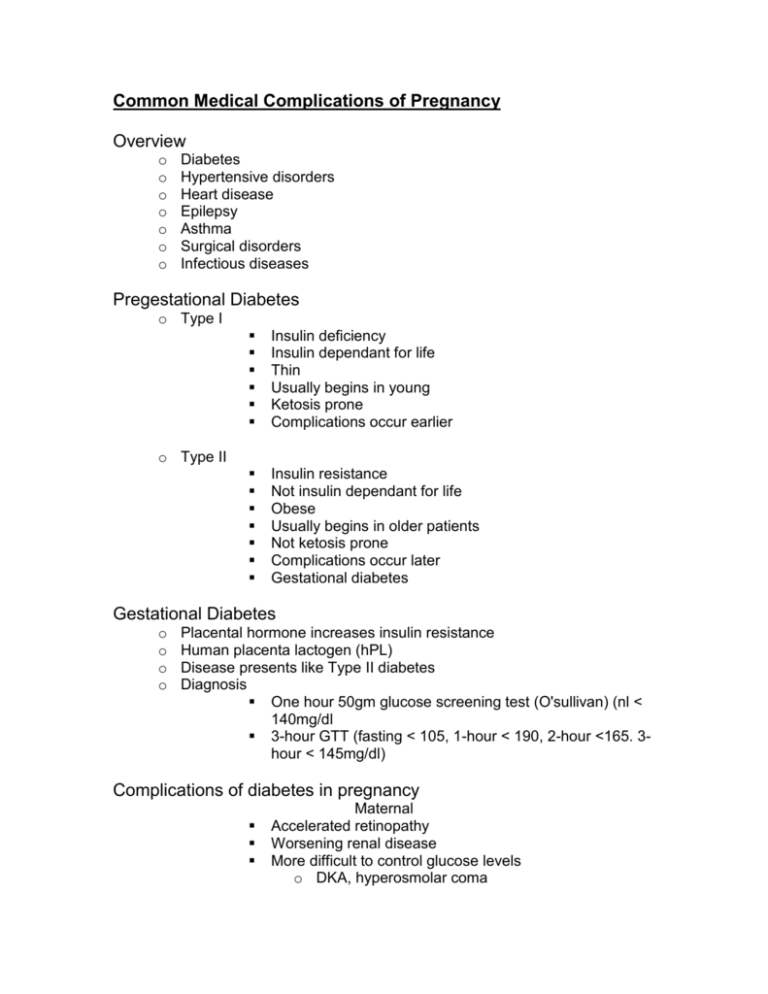
Common Medical Complications of Pregnancy Overview o o o o o o o Diabetes Hypertensive disorders Heart disease Epilepsy Asthma Surgical disorders Infectious diseases Pregestational Diabetes o Type I Insulin deficiency Insulin dependant for life Thin Usually begins in young Ketosis prone Complications occur earlier Insulin resistance Not insulin dependant for life Obese Usually begins in older patients Not ketosis prone Complications occur later Gestational diabetes o Type II Gestational Diabetes o o o o Placental hormone increases insulin resistance Human placenta lactogen (hPL) Disease presents like Type II diabetes Diagnosis One hour 50gm glucose screening test (O'sullivan) (nl < 140mg/dl 3-hour GTT (fasting < 105, 1-hour < 190, 2-hour <165. 3hour < 145mg/dl) Complications of diabetes in pregnancy Maternal Accelerated retinopathy Worsening renal disease More difficult to control glucose levels o DKA, hyperosmolar coma o Hypoglcemia Pregnancy induced hypertension Fetal complications of maternal diabetes Congenital anomalies o Congenital heart disease (VSD, transposition of the great arteries) o Neural tube defects o Caudal regression Macrosomia, intrauterine growth restriction (IUGR) Stillbirth Neonatal complications of maternal diabetes Hypoglycemia Hypocalcemia Respiratory distress syndrome Management of Diabetes in Pregnancy Tight control essential Diet – 30-35 kcal/kg ideal body weight ADA diet Glucose testing - fasting and 2-hours following meals o FBS <105mg/dl o 2-hour PP <120mg/dl Medical therapy Oral glyburide (Diabeta) Humolog (Lispro)– peak = 30 min, duration = 1 hr Regular insulin - peak = 2-3 hr, duration = 6-8 hr NPH or Lente insulin – peak = 6-12 hr duration = 16-24 hr Ultralente – peaks 10-16 hr, duration 36+ hr Infusion pump Insulin therapy protocols Morning and HS NPH, regular before breakfast and dinner Morning Ultralente, premeal regular Evening NPH, premeal humolog Infusion pumps Prevention of complications o o o o Birth defects – preconceptional control, folic acid Stillbirth- nonstress testing (NST) at 28-32 weeks, early delivery RDS – amniocentesis for phosphatidyl glycerol (PG) or FLM Birth trauma – if the estimated fetal weight > 4200gm, consider cesarean delivery o Neonatal hypoglycemia – tight control, especially at delivery – treat early o Pregnancy Induced Hypertension (PIH,Preeclampsia) Pregnancy Induced Hypertension (PIH, Pre-eclampsia) o Etiology = unknown o Pathophysiology = vasospasm Diagnosis o BP > 140/90 (2 readings 8 hours apart) o Proteinuria (> 300mg/24hr or 1-plus) o Nondependent edema (hand and face) Manifestations of PIH o o o o o o o o o o o o Seizures (eclampsia) Intracranial bleeding Headaches Visual disturbances (ischemia, retinal detachment) Pulmonary edema Epigastic or RUQ pain (liver capsule edema or rupture) Manifestations of PIH HELLP syndrome Hemolysis (falling Hct, increased LDH, framented RBCs) Elevated liver enzymes (AST, ALT, Bilirubin) Low platelet count (<100,000/cc) Poor fetal growth, oligohydramnios, stillbirth Abruption Renal Decreased renal blood flow - oligouria Glomerular capillary endotheliosis Increased proteinuria Decreased creatinine clearance, increased serum creatinine Disseminated intravascular coagulation (DIC) Capillary endothelial damage Hemolysis Platelet consumption Activation of coagulation cascade Management of PIH o Cure = delivery o Bed rest if premature and disease is not severe Follow with NSTs Serial ultrasounds to assess fetal growth, and well being (biophysical profile) Follow maternal signs, symptoms and labs When delivery is mandatory. Term pregnancy Evidence of severe disease BP > 160/110 Headaches, visual disturbances, epigastric or RUQ pain Seizures Pulmonary edema HELLP syndrome Oligouria or >5gms proteinuria/24 hours IUGR, fetal distress, oligohydramnios DIC Essential hypertension in pregnancy Complications o Poor fetal growth o Stillbirth o Superimposed preeclampsia o Worsening renal disease Management 2 week visits until 36 weeks, then weekly Serial ultrasounds for fetal growth and well being Baseline renal function studies Serum creatinine (nl < 0.9mg/dl) 24-hour urine protein (nl < 300mg) Creatinine clearance ( nl > 100cc/min) NST beginning at 32 weeks Watch for superimposed preeclampsia Delivery in 39th week Medications for hypertension in pregnancy (<150/100) Methyldopa o Central alpha stimulator o Long term studies prove safety and efficacy o Side effects = somulence, hemolytic anemia, positive Coombs Beta-blockers (propanolol) o Reported to be associated with IUGR o Probably safe Combined alpha and beta blocker (lebatolol) o Safe and effective Alpha blockers (prazosin,) Calcium channel blockers (nifedipine) o Effective and apparently safe o Headaches are a common side effect Direct vasodilator (hydralazine) o Best used IV – PO dose affected by 1st pass effect Hydrochlorothiazide o Prevents volume expansion o Neonatal thrombocytopenia reported Angiotension converting enzyme (ACE) inhibitors Contraindicated in pregnancy Reported complications o Oligohydramnios o Neonatal renal failure o Perinatal mortality Indications for delivery with essential hypertension 39 weeks Fetal distress IUGR Oligohydramnios Severe superimposed preeclampsia Heart disease in pregnancy Normal signs and symptoms of pregnancy that mimic heart disease o Shortness of breath o Chest pain (expansion of rib cage) o Nocturia o Edema o Jugular venous distension o EKG - nonspecific ST changes, PVCs, left ventricular hypertrophy, left axis deviation o Chest X-ray - enlarged cardiac silhouette o Echocardiogram - dilation of ventricles and tricuspid regurgitation Keep mother healthy, and the fetus should do well Avoid fluid overload and anemia Severe cases require bed rest sometimes in the hospital for the entire pregnancy Vaginal delivery is usually preferred (exception = Marfan syndrome) Anesthetic considerations require early consultation 28-32 weeks and immediately post partum critical times Congenital heart disease Stenotic lesions do worse in pregnancy Insufficiency lesions improve Eisenmenger syndrome had highest mortality risk Treatment in pregnancy is similar to non pregnancy Epilepsy in pregnancy Pregnancy probably has little effect of the disease course (thirds rule) Medications are associated with congenital anomies o Fetal hydantoin syndrome (face and hand abnormalities) o Neural tube defects (valproic acid) Seizure frequency also increases risk of anomalies Increases risk greater than medication Medication dose needs to be increased because of increased plasma volume Patients stop meds because of fear of birth defects If no seizure in 2 years, you can attempt to stop medication Asthma Reversible airway obstruction Pregnancy probably does not affect the course of the disease Treatment should not be altered because of pregnancy Peak flow (<80% seek medical attention) Inhaled -2 sympathomemitics Inhaled steroids IV steroids Theophylline (used infrequently) Normal or rising pCO2 levels is an ominous finding Surgical disorders Cholelethiasis and cholecystitis Increased frequency in pregnancy (estrogen effect) Diagnosis = ultrasound Treatment o Expectant (pain meds, avoid fatty foods) o If symptoms are severe or with obstruction of the CBD, surgery can be safely performed - preferably in the 2nd trimester. Appendicitis o Diagnosis is difficult WBC up to 15,000 can be normal in pregnancy Appendix rises with the enlarging uterus – site of pain not in classical location Many normal women have abdominal pain o Delayed diagnosis can have disastrous consequences Septic shock and maternal death Preterm labor Abortion o When in doubt – surgery should not be delayed Trauma in pregnancy Fetus nonviable – treat mother 1st o Perform all diagnostic studies required (up to 5 rads of X-ray considered safe to fetus) o Perform surgery as required Viable fetus - treat mother 1st o Monitor fetal heart tones o Deliver the baby if visualization is hampered by the enlarged uterus or with fetal distress o Perform all necessary diagnostic studies Infectious diseases in pregnancy Group B beta hemolytic streptococcus (GBBS) o The most common infectious agent causing neonatal death o Maternal post partum endometritis o No effect on the pregnancy before labor and delivery Group B beta hemolytic streptococcus (GBBS) Risk factors for neonatal infection o Previous history o Prematurity o Prolonged rupture membranes (>18hours) o Maternal temperature > 38 degrees centigrade Prevention of GBBS neonatal infections Antenatal Penicillin G or Ampicillin Who should receive treatment o Threatened preterm birth (labor or PROM) o Women with a previously affected child o Fever in labor o Prolonged ruptured membranes o Asymptomatic carriers of GBBS Pylonephritis in Pregnancy Increased incidence in pregnancy Dilatation of ureters (progesterone effect) Ureteral obstruction (right ureter by the enlarged uterus increased glucosuria Right ovarian vein dilation can kink the right ureter Asymptomatic bacturia leads to pyelonephritis 2040% of time Most common organisms E. Coli Klebsiella Proteus GBBS Complications of Pyelonephritis in Pregnancy Premature labor and delivery Septic shock Adult respiratory distress syndrome Hepatitis B No specific treatment to mother – pregnancy has little or no effect on the disease Newborns most commonly infected during delivery Newborns should receive hepatitis B immune globulin and the vaccination TORCH infections: Toxoplasmosis o Undercooked infected meat o Cat litter Newborn sequellae o Microcephaly, hydrocephaly o Mental retardation o hepatosplenomegaly Diagnosis of Toxoplasmosis IgM maternal antibodies 4 fold rise in IgG in paired samples Amniocentesis - presence of toxoplasmosis DNA or culture Fetal blood - + IgM antibodies Treatment Pyrimethamine, sulfasalizine Spiramycin Syphilis Screening tests = VDRL, RPR, ART Confirmatory tests = FTA-ABS, MHA-TP, TPI Suspicious Lesion = dark field Treatment of Syphilis in pregnancy Early latent (< 1 year duration) = 2.4 million units PCN G Late latent (>1 year duration) = 2.4 million units weekly x 3 doses PCN G Tertiary syphilis = IV penicillin Penicillin allergic requires desensitization in pregnancy to prevent congenital syphilis HIV infections in pregnancy Maternal treatment should not be altered by pregnancy Zidovudine (AZT) reduces vertical transmission from 25% to 5% Cesarean section prior to labor reduces it further to 2-3% Routine screening of all pregnant women is recommended Rubella infections Incidence is now rare because of vaccine 1st trimester maternal infection less likely transmitted to the fetus but is associated with the most severe defects. o Blindness o Deafness o Microcephaly o Mental retardation Later infections usually cause no fetal problems Diagnosis of maternal rubella infections IgM antibodies 4-fold increased IgG antibodies in paired sera There is no specific treatment Cytomegalovirus (CMV) infections The most common prenatally acquired infection Primary infection most likely to cause fetal problems o Hydrocephaly, microcephaly o Mental retardation o Blindness or deafness CMV infections + IgG (past infection) or IgM (recent or recurrent infection) Routine screening not recommended Risk of transmission = 40% o 10% will be affected at birth 10% of unaffected newborns show delayed effects (hearing deficits, developmental delays, learning disabilities) Herpes simplex virus (HSV) type II Perinatal transmission usually acquired during vaginal delivery Most common with a primary maternal infection Mortality rate > 50%, survivors usually have severe disabilities Cesarean delivery for women with active genital lesions is recommended






